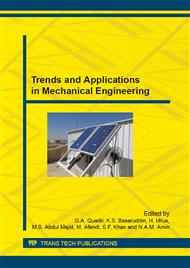[1]
G. . K. Batchelor, An Introduction to Fluid Dynamics, Cambridge University Press, (2000).
Google Scholar
[2]
B. A. Toms, Observation on the flow of linear polymer solutions through straight tubes at large Reynolds numbers, International Congress on Rheology, pp.135-141, (1949).
Google Scholar
[3]
Y. Dubief, V. E. Terrapon, C. White, E. Shaqfeh, P. Moin and S. Lele, New Answers on the interaction between polymers and Vortices in Turbulent Flows, Flow, Turbulence and Combustion, pp.311-329, (2005).
DOI: 10.1007/s10494-005-9002-6
Google Scholar
[4]
I. Azouz, S. N. Shah, P. S. Vinod and D. L. Lord, Experimental Investigation of Frictional pressure losses in coiled tubing, SPE Production & Facilities, Ohio, (1998).
DOI: 10.2118/37328-pa
Google Scholar
[5]
W. R. Dean, Proc. R. Soc. Ser. A, vol. Vol. 121, no. 787, p.408, 1928-11.
Google Scholar
[6]
C. M. White, Streamline Flow through Curved Pipes, Procedings of the Royal Society of London, pp.645-663, (1929).
Google Scholar
[7]
H. Ito, Friction Factors for Turbulent Flow in Curved Pipes, Journal of Basic Engineering, pp.123-134, (1959).
Google Scholar
[8]
P. C. R., Non-Newtonian Fluids: An Introduction, SERC School-cum-Symposium on Rheology of Complex Fluids, (2010).
Google Scholar
[9]
W. S. B. G., C. H. J. and W. A., The Flow of Cream through Narrow Glass Tubes, Journal of physical chemistry, p.853–864, (1939).
Google Scholar
[10]
J. C. Pierre, Rheological equations from molecular network, Journal of Rheology, p.99–127, (1972).
Google Scholar
[11]
K. Yasuda, Investigation of the analogies between viscometric, Massachusetts Institute of Technology, Massachusetts, (1979).
Google Scholar
[12]
J. W. Hoyt, Drag reduction in polysaccharide solutions, Trends in Biotechnology, pp.17-21, (1985).
Google Scholar
[13]
N. A. and M. Y., Effects of solvent and concentration on scission of polymers with high-speed stirring, Journal of Applied Polymer Science, vol. 19, no. 8, p.2119–2130, (1975).
DOI: 10.1002/app.1975.070190806
Google Scholar
[14]
T. Moussa, C. Tiu and . T. Sridhar, Effect of solvent on polymer degradation in turbulent flow, Journal of Non-Newtonian Fluid Mechanics, vol. 48, no. 3, p.261, (1993).
DOI: 10.1016/0377-0257(93)87024-j
Google Scholar
[15]
ANSYS, Meshing Methods: Tetrahedral, 14 May 2014. [Online]. Available: http: /www. ansys. com/Products/Workflow+Technology/ANSYS+Workbench+Platform/ANSYS+Meshing/Features/Meshing+Methods: +Tetrahedral.
DOI: 10.1201/b18949-12
Google Scholar
[16]
S. V. Patankar, Numerical Heat Transfer and Fluid Flow, Washington D.C.: Hemisphere, (1980).
Google Scholar
[17]
J. S. Paschkewitz, D. Yves and E. S. G. Shaqfeh, The dynamic mechanism for turbulent drag reduction using rigid fibers based on Lagrangian conditional statistics, Physics of Fluids , vol. 17, no. 6, (2005).
DOI: 10.1063/1.1925447
Google Scholar


